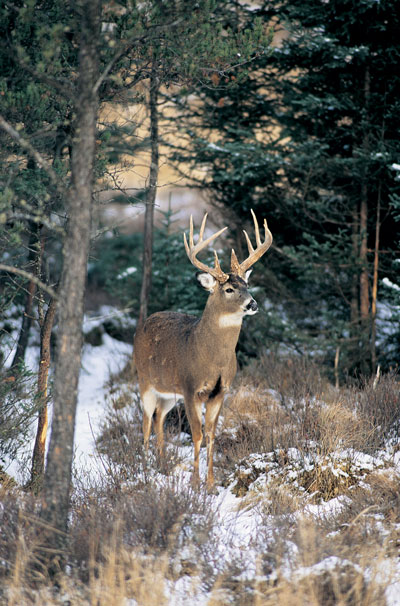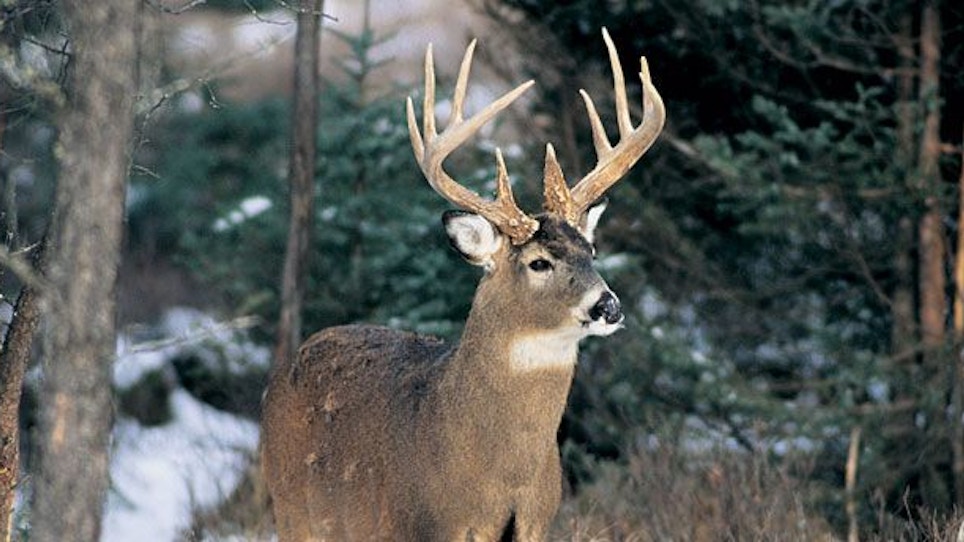 As 10 a.m. evaporated into November’s chilly air, I heard leaves crunch and twigs snap—the unmistakable sounds of whitetail trotting over the crest of a wooded rise a hundred yards away. The sounds paused, and then resumed. My eyes strained to detect a deer among the maples and spruce, and then sunlight glimmered off antlers and brown hair. The buck spun and trotted down a crease in the hillside toward a forest opening some 50 yards distant.
As 10 a.m. evaporated into November’s chilly air, I heard leaves crunch and twigs snap—the unmistakable sounds of whitetail trotting over the crest of a wooded rise a hundred yards away. The sounds paused, and then resumed. My eyes strained to detect a deer among the maples and spruce, and then sunlight glimmered off antlers and brown hair. The buck spun and trotted down a crease in the hillside toward a forest opening some 50 yards distant.
When the buck stopped again, he stuck his nose into a scrape and sucked so much air through his nostrils that the vacuuming noise startled me in my treestand. The sounds made me envision odor molecules from deer urine, tarsal glands and pungent dirt rolling upward across the hundreds of millions of scent receptors in the buck’s nasal passages. After analyzing these varied odors, the buck twisted and yanked on the scrape’s licking branch, looked around with quick jerks, and then trotted straight for my tree.
I came to full draw. Just as I prepared to grunt the 2.5-year-old buck to a stop as he passed broadside at 15 yards, he turned like a bird dog and buried his head behind a fallen balsam fir. Again, he sucked up scent molecules from a scrape that had opened since my last visit.
Still at full draw, I waited for the buck to finish his scent analysis. I figured I would shoot when he again paused to work an overhanging branch before moving off on his search for does. Unfortunately, that never happened. Before I could press the release trigger, the buck whirled away from the scrape and trotted into the spruce and balsam. Seconds later, I heard the sounds of rubbing, flying dirt and debris, breaking branches, and then more vacuuming and snarfing. If the buck ever detected the grunts from my deer call, he didn’t let on. He left the area in the same ground-eating gait that had brought him there just minutes earlier.
Forget Patterns
I think of that buck and his quick, erratic, unpredictable cruise through a forested creek bottom every time someone wants to discuss deer patterns and methodical hunting tactics, or debate what deer always do or never do. There’s no doubt deer follow some general patterns early and late during bow season, but during the rut? The more I hunt whitetails during this chaotic time, the more I believe in finding good funnels in the terrain and waiting for deer to bounce and careen through the chute. Either that, or I set up over an open food source where does often feed, and hope my decoy coaxes a rut-deranged buck into range. Sure, I try scents, calling, and rattling, but I’ve yet to detect any real patterns in their effectiveness.
The rut will always be a time of boredom, excitement, frustration, random chance and heart-stopping action; sometimes all five in five minutes. It’s nothing new—long before the age of compound bows, hunters reached the same conclusion.
Perhaps we get frustrated because the bucks themselves are frustrated. In fact, the term “rut” probably evolved from the bucks’ expressions of irritated rage. My friend Ian Alcock, a Scottish hunter, deer farmer, and longtime deer enthusiast, says the word “rut” was already in use when the book, The Master Of Game, was written between 1406 and 1413. Alcock says “rut” likely derived from the old French ruit, which in turn probably came from the Latin rugire, meaning “to roar.” And he reminds America’s elk, moose, and deer hunters that “rut” also is applied to wild sheep and wild cattle, not to mention Europe’s red deer and roe deer.
OK, but how did we get “rut” from “roar,” and where did “roar” come from in the first place? Alcock explained the word’s evolution in a recent correspondence. He wrote: “It is always thought that cold, frosty weather at night causes red deer stags to roar more often or start them roaring. The Master Of Game quotes words to the effect that (red deer) stags start to roar 15 days before the end of the Time of Grease, i.e., when they are fat and in top condition. All this activity—roe deer chasing about, stags roaring, and so on—is what we call the rut, but much of it is actually frustration demonstrated by males waiting for females to come into estrus.”






